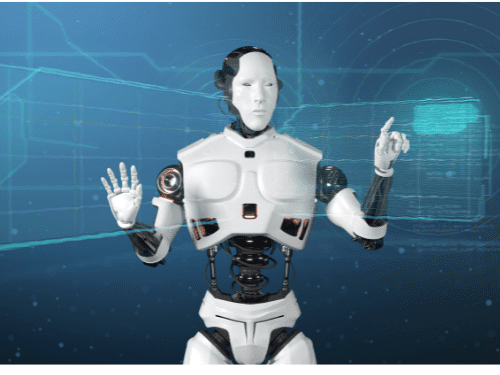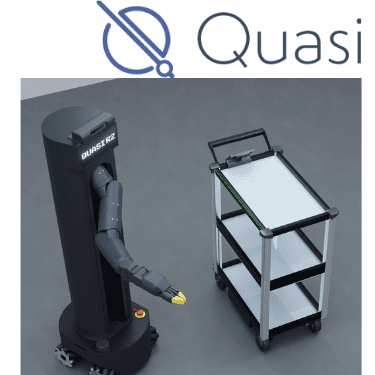
By Anna Eyler
In a rapidly evolving business landscape, startups that don’t consider implementing emerging technologies like artificial intelligence (AI) and robotics into their operations are at risk of being left behind. Leveraging these tools allows employees to spend more time and energy on strategic tasks that require high-level critical thinking. By integrating AI-driven algorithms and robotic systems into their operations, startups can increase their efficiency, enhance productivity, and deliver superior customer experiences
AI allows businesses to work faster and do more with less. Many startups don’t have the budget to hire a graphic designer or copywriter, but they can use AI tools to create images and text for social media posts, email campaigns, websites, etc. AI can also send email campaigns at optimal times to maximize open rates and engagement. Startups can leverage AI to produce SEO-optimized blog posts, establishing an online presence in their industry. However, it’s crucial to thoroughly edit and fact-check any AI-generated content before publication.
Using historical data, AI can predict future trends and outcomes in customer behavior, inventory management, sales forecasting, and more. It can also analyze market trends and public sentiments to better understand the landscape businesses are operating in. Instead of focusing on time-intensive research, employees can turn their attention to activities like innovation and product development, customer relationship building, learning and professional development, etc.
Companies that automate sales processes see efficiency improvements of 10% – 15%, while also having higher levels of customer satisfaction.

Through automation, AI and robotics can save businesses time and money while delivering a better customer experience. Companies that automate sales processes see efficiency improvements of ten to fifteen percent, while also having higher levels of customer satisfaction. Robotic Process Automation (RPA) automates repetitive tasks like data entry and form filling, while eliminating human error.
While a majority of startups are enthusiastically experimenting with AI, many are hesitant to incorporate robotics into their businesses, largely due to initial investment costs. This hesitation is understandable, but you must keep in mind that robotics can help scale businesses rapidly by accelerating production. They also improve accuracy and consistency, all without needing to add to the company’s workforce. It can also free employees from monotonous, repetitive and even dangerous tasks so they can focus on strategic tasks that lead to even more growth. It’s almost like hiring an assistant, but the cost of a robot is significantly less than the salary and benefits required to support a full-time employee. And you wouldn’t want to hire an employee for the tasks that would be delegated to a robot anyway because they would not be fulfilled or satisfied.
Even if you cannot implement robotics into your business tomorrow, start the discovery and education process now. Identify tasks suitable for automation, including those that are repetitive, demand higher labor intensity, or that raise safety concerns. Then, evaluate available robotic technologies and choose solutions that align with the business’ specific needs and budget, taking into consideration that robotics have the potential to deliver great returns on investment. Collaborating with robotics experts or consultants, like Vladimir Lebedev, CEO of Quasi Robotics, can provide valuable insights and ensure smooth integration.
Quasi Robotics builds intelligent autonomous mobile robots (AMRs) that integrate effortlessly with existing facility systems and machines. Their Model C2 AMR Robot is an autonomous delivery cart that can navigate facilities to deliver materials. Their Model R2 AMR is a mobile manipulation robot optimized for material handling and task completion. The AMRs are powered by Quasi Robotics’ adaptive Q.AI Integrated Automation Platform, which uses proprietary algorithms to enable real-time learning, obstacle avoidance and optimal decision-making. Both models of AMRs have great applications for life sciences, research and laboratories. They can optimize the safe handling of hazardous materials, station turnover and waste management, sample process prioritization and more.

As robotic systems only become more prevalent in our society moving forward, robotics clubs are preparing children to be part of a future workforce that can build, operate, and innovate these systems. Katya Vert-Wong, CEO of Nostopharma, runs one such club called Always Improving, or A.I. (a nod to artificial intelligence). The team of seven young engineers, ranging from the ages of 10 to 12, is in its second year of competing in the First LEGO League Challenge. The program challenges youth to design, build, and program autonomous LEGO robots to complete a series of missions on a thematic playing field.
As each year passes, more graduates will enter the workforce ready to implement robotic systems. We don’t recommend diving in headfirst without having done proper research and a cost-benefit analysis. However, we also caution you not to dismiss robotics as a distant prospect of the future. As technology advances, these systems will become more affordable, and more people will have the knowledge and experience to work with them. Many pioneering startups are already planning for their implementation. Is your business ready to leverage these skills and systems to increase productivity and maintain your competitive edge?
Explore the future of AI and meet these leaders in the Technology Pavilion of FITCI’s launch celebration for Maryland’s EDGE at 321.
Register for the July 18, 2024 event at https://fitcinc.ticketleap.com/grand-opening/

